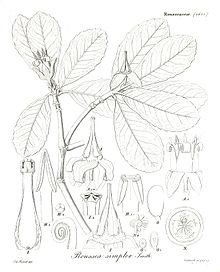Roussea simplex
| Roussea | |
|---|---|
 |
|
| Drawing from Iconographia generum plantarum, F. Beck, 1838 | |
| Scientific classification | |
| Kingdom: | Plantae |
| (unranked): | Angiosperms |
| (unranked): | Eudicots |
| (unranked): | Asterids |
| Order: | Asterales |
| Family: | Rousseaceae |
| Subfamily: |
Rousseoideae Horan. |
| Genus: |
Roussea Sm. |
| Species: | R. simplex |
| Binomial name | |
|
Roussea simplex Sm. |
|
Roussea simplex is a woody climber of 4–6 m high, that is endemic to the mountain forest of Mauritius. It is the only species of the genus Roussea, which is assigned to the family Rousseaceae. It has opposing, entire, obovate, green leaves, with modest teeth towards the tip and mostly pentamerous, drooping flowers with yellowish recurved tepals, and a purse-shaped orange corolla with strongly recurved narrowly triangular lobes.
Roussea simplex is a liana of 4–6 m high. The wood vessels have very oblique oval openings which are subdivided by about 20 (maximally 50) bars (this is called scalariform), while the side walls have pits in rows and lack spiral-shaped thickenings. Its young stems are firm and have thick nodes. Leaves are set opposite to each other, but several pairs can be close to each other creating a whorl-like cluster. Stipules at the base of the leaf stems are absent, while the leaf stems themselves are about 1 cm long and are covered with felty hairs. The leaf blades are robust, large, and have a long inverted egg-shape (7–12 × 3–5½ cm). The base is rounded to slightly wedged, the margin is slightly serrated, particularly in towards the tip and the tip is pointed or blunt. The top of the leaf blade is darker green and without hair, the underside is lighter and has some hair. The light green main vein splits pinnately and the secondary veins end at the leaf margin. The leaves contain long resin channels. Glandular peltate hairs are said to be present.
In the axis of the leaf mostly single (but occasionally up to four) pendulous flowers arise on a flowerstem of about 2 cm long that is covered in felty hairs. These flowers are mostly pentamerous (but sometimes 4-merous), large and robust, measuring approximately 2½ cm. The flowers have a slightly sweet scent reminiscent of yeast, a possible adaptation to the preference of the gecko pollinator. The anthers are ripe before the stigmas, meaning that individual flowers are first male and subsequently female (or protandrous). The sepals are leathery, persistent, initially spreading and whitish during the male phase, to become more yellowish and deflexed during the female phase, and eventually more or less spreading again and pale green during development of the fruit. The corolla is bell- or purse-shaped, strongly deflexed in the upper half, with individual petals thick, long egg-shaped to narrowly triangular, yolk yellow near the base and gradually becoming a warm orange near the tip, with felty hairs on the outside, more dense toward the tip. The stamens alternate with the petals, are yolk yellow, large, completely covering the ovary and pistil, with filaments triangular and leaning towards the middle, with large anthers facing outwards, away from the stigma. The pollen grains are circular, 25–30 μm in diameter, secreted in a wet, sticky, yellowish fluid, which easily attaches to smooth surfaces. After three to four days the stamens drop from the flower and so reveal the pale female parts, which have a large central style and a bud-shaped stigma, that is greenish in the male phase and turns yellow in the female phase. The fruit is a pale green berry shaped like an angular flat onion. It contains many minute, flat and ovoid seeds. Nectar is released in generous quantities during both male and female phases.
...
Wikipedia
